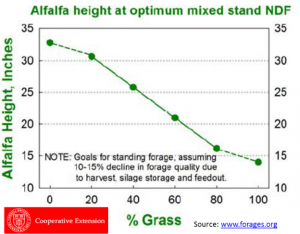This is the team’s third week of monitoring alfalfa heights for first cutting quality in 2025. The full report for our six-county region (Broome, Cayuga, Chemung, Cortland, Tioga, and Tompkins Counties) can be found in the following link: Alfalfa Height Reporting Sheet 5.20.25
This week’s updates:
This past week saw on average over 6″ of growth across the region. Some more farms with mixed grass/alfalfa rolled the dice on the weather the last few days and have been harvesting. Janice noted some lodging in stands she monitors in Tompkins and Cortland counties, with some alfalfa at early bud stage, and orchard grass headed out.
The next window of opportunity the weather gives, all fields for the most part will be at peak or past peak quality, so be ready to go when the window opens.
Broome: average heights were over 28″ here, gaining over 6″ from last week. Mixed plots are ready and alfalfa fields are approaching peak quality.
Cayuga: average heights were over 23″ here, but still a wide range between fields. Best to check local conditions for determining quality – mixed stands are at peak and pure alfalfa stands are approaching peak quality in some locations. Gains were over 6.5″ from last week
Chemung: average heights were 25.5″ gaining 6″ from last week. Alfalfa will be at peak quality next week.
Cortland: average heights were 26″, gaining almost 8″ from last week. Mixed fields are ready to be harvested and pure alfalfa is almost ready.
Tioga: average heights were over 27″, gaining over 6″ from last week. Mixed fields are at peak, and pure alfalfa soon will be.
Tompkins: fields here averaged 29″, gaining almost 8″ from last week. Check local conditions – likely fields will be at peak quality in our next window of opportunity.
Update from Joe Lawrence, Cornell PRO-DAIRY
Spring wet weather forage management strategies
With wet conditions persisting in many areas of the state in the second half of May, it is time to start thinking about and adjustments to forage strategies.
Hay Crop
Most grass hay crops and winter grains are past their optimum for lactating cow quality feed. As weather windows allow, target mixed stands and legumes that are still in the window for optimum lactating cow feed.
Return to over mature fields after all lactating quality feed is harvest and consider alternative storage strategies for over mature hay finding ways to store it separate from lactating quality feeds so it can be used for appropriate animal groups on the farm.
Corn Silage
The remainder of the growing season will have a significant impact of the outcome of the crop and while adjustments to corn relative maturities often begin by May 20 to 25 it is important to not overreact. While data suggest that yields can begin decline after late May, this is not always the case. When a good growing season follows late planting, performance and weather (yield and silage nutritional value) remains competitive.
One thing that always challenges crop performance is planting into wet soil conditions. Even as we enter late May, waiting a few extra days for optimum soil conditions is a preferred tradeoff to “mudding it in”.
If planting delays persist through the end of the May, review growing degree day (GDD) requirements for selected hybrid relative maturities and average GDD accumulation for your location. While it is not possible to predict the remainder of the growing season, using the best available information helps reduces the risk of making unnecessary adjustments
Additional Resources
Additional resources can be found on the PRO-DAIRY Forage Systems webpage.
- First cutting: Resources for success in 2022
- Storage strategies for over mature hay and securing extra forages
- Resources for dealing with spring weather delays
- Late spring: Forage considerations beyond corn
- Late planted corn for silage and GDD accumulation
A Reminder on our Methods
For prediction of NDF content, the height of alfalfa as an indicator is as follows:
- 100% grass stands – cut when nearby alfalfa is 14 inches tall (achieves 50% NDF)
- 50/50 grass/alfalfa stands – cut when nearby alfalfa is 22 inches tall (achieves 44% NDF)
- 100% alfalfa stands – cut when alfalfa is 28 inches tall (achieve 40% NDF)

Predicted days to cut are based on daily NDF increases for grasses of 1.0% point, 50/50 mixed alfalfa/grass stands of 0.8% points, and alfalfa of 0.5% points and are adjusted for the coming week’s weather. Typically NDF increases about 0.8 to 1.2 per day for grasses, with cooler weather being the lower end of the range and warmer weather being the higher end. For alfalfa, NDF increases about 0.4 to 0.7 per day, also dependent upon warm/cool weather.
Next Report
Look for our final report of monitoring heights to come out on Wednesday, May 28th. We will also be analyzing grass maturity throughout the month of May and early June, utilizing scissor cuts to help assess maturity for other classes and species of livestock.
In the meanwhile, if you can’t get out to check your fields, call one of us on the team. We’ll be glad to help out.

